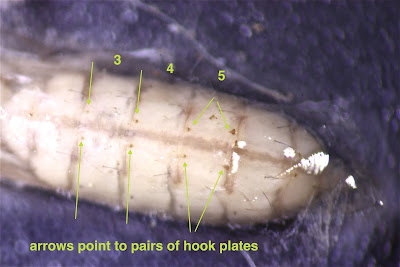The caddis pupa that I found at the Upper Doyles River on Thursday (12/22) -- in the photo above -- turned out to be a Fingernet pupa (family: Philopotamidae) -- genus Dolophilodes. I may be the only one who wanted to know -- but I did want to know. So, this morning I carefully removed the cocoon from its protective rock case: it slipped right out, by the way, it wasn't glued fast to the enclosure (this is important for genus ID).
For pupa identification, we have to use Merritt, Cummins, and Berg, eds., An Introduction to the Aquatic Insects of North America (Fourth Edition, 2008). This key requires us to look at the dorsal (top) side of the abdomen and count the number of "hook plates" on each abdominal segment: critical, are the number of pairs on segments 3, 4, and 5.
As you can see, segments 3 and 4 each have one pair of hooked plates (which show up as little brown dots), while segment 5 has two. Let's turn to couplet 2 for caddis pupae in Merritt, Cummins, and Berg (p. 460).
2. Abdominal segments III, IV, and V each with two pairs of hook plates.....3
2'. Abdominal segment III with no more than one pair of hook plates, segments IV and V each with two pairs of hook plates, or two pairs of hook plates present only on segment V....4 (italics added)
Clearly, we have to move to couplet 4 -- not 3.
4. Abdominal segment IV with one pair of hook plates; segment V with two pairs of hook plates. ...
Philopotamidae
4'. Abdominal segments IV and V each with two pairs of hook plates ....5
No need to go on to 5. This is a Philopotamid pupa -- Fingernet caddis. I'm not surprised. I've been seeing a lot of mature fingernet larvae in a lot of our streams throughout the fall.
And, we can be pretty sure this is genus Dolophilodes since the cocoon was not firmly attached to its enclosure. Glenn Wiggins (Caddisflies: The Underwater Architects, p. 62) says the following on this point: "Moreover, in the philopotamid genus Dolophilodes the cocoon is not fastened to the interior wall of the dome but remains free; and if the dome of rock fragments is carefully pried from the rock substrate, the cocoon can be removed intact... ." And here is the cocoon -- intact. (Eerie! It looks for all the world like the pupa is smiling!)
___________
Below, the "dome" enclosing the pupa as seen from above -- and a Dolophilodes Fingernet larva.



No comments:
Post a Comment